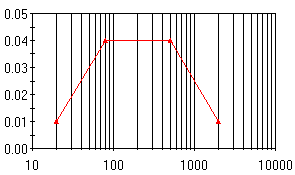Random Vibration Analysis
Use a random vibration study to calculate the response due to non-deterministic
loads. Examples of non-deterministic loads include:
loads generated on a wheel of a car traveling
on a rough road
base accelerations generated by earthquakes
pressure generated by air turbulence
pressure from sea waves or strong wind
In a random vibration study, loads are described statistically by power spectral density (psd) functions.
The units of psd are the units of the load squared over frequency as a
function of frequency. For example, the units of a psd curve for pressure
are (psi)2 / Hz over Hz.
A sample psd curve is shown below. The X axis (frequency Hz) is plotted
on a logarithmic scale for a clear illustration of the wide frequency
range. The unit for Y-axis is amplitude2/
frequency.

The solution of random vibration problems
is formulated in the frequency domain. Click here
for details.
After running the study, you can plot root-mean-square
(RMS) values, or psd results of stresses, displacements, velocities, etc.
at a specific frequency or graph results at specific locations versus
frequency values.
Damping Effects
Modal, Rayleigh, and Composite modal
damping options are available for this type of analysis.
Related Topics
When
to Use Dynamic Analysis
Definitions
Damping Effects
Loads
and Result Options for Dynamic Analysis
Performing
Linear Dynamic Analysis